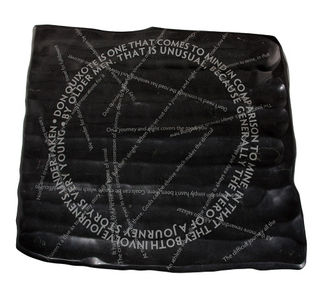TREK: Following Journeys
EXHIBITION TEXT
Group Exhibition
16.05.15 – 27.06.15
Cape Town
The title of the exhibition, Trek, is a word that evokes various responses and has different connotations from Star Trek to the Great Trek. The Great Trek commenced in the Cape in 1834 and this historic journey into the Southern African interior, by ‘displaced’ European settlers, provides a purposefully controversial backdrop to the show, which deals with the concepts of migration, travel and displacement in the African context.
In modern South African parlance or slang, the word ‘trek’ refers to moving, as in relocating, or to a difficult or uncomfortable trip, such as a long drive through heavy traffic from one side of the city to another. The arduous daily travel routine of most Africans living on the outskirts of sprawling cities such as Lagos and Johannesburg and the correlated social issues surrounding this antiquated system, as well as the general lack of public transport on the continent, has become an ingrained frustration and inhibitor to progress and advancement. Mozambiquean artist Filipe Branquinho’s stitched images of merged, elongated African taxis or minibuses are a tactfully composed and witty take on the subject. Gripping and gritty images from Porto Novo, by Beninese photographer Leonce Raphael Agbodjelou extends this conversation by virtue of stark and vivid images of young scooter-riders in peak midday traffic.
Portraits by young South African artist, Sipho Mpongo, of township dwellers originating from the far-off reaches of Southern Africa, are complimented by an eerie image of an empty or abandoned train cabin. Renowned Ethiopian artist Michael Tsegaye has produced evocative and atmospheric photos of dessert Nomads found in some of the most inhospitable and uninhabitable terrain imaginable, constantly moving across the plains of the Danakil Depression, south of the Eritrean border – one of the lowest lying and hottest pieces of land in the world. South African artist Nomusa Makhuba creates collaged photographic images, taken from behind broken windscreens, entitled “Inquietude” and presented in the form of a triptych. In the artist’s own words, “this project was based on interrogating notions of being ‘in and out of place’ (Cresswell 1996), as well as histories of belonging and dispossession”.
Closely linked to the idea of transportation in modern Africa, are the complexities surrounding oil, Africa’s “Black Gold” and the way in which this controversial resource is managed by the various governments and powerbrokers, ranging from corruption, conflict and exploitation, to pollution and the environment. Akintunde Akinleye’s photos of oil poachers in the Niger Delta touch on all these issues and accentuates the raw and informal manner in which oil is found, extracted and smuggled, with all the associated dangers which the subjects face.
Gareth Nyandoro’s installations, which include three dimensional objects and delicate woven images on paper, mounted on canvas, are inspired by the stalls of temporary street vendors found all over Africa but especially on the streets of his native Harare – these illegal traders need to be flexible and mobile in order to avoid police attention.
Zimbabwean artist Masimba Hwati creates suggestive and subtle sculptures incorporating worn-through old shoes and found objects. These shoes contain the lives and journeys of those who wore them and their origins tell of individual histories, whilst Masimba’s interventions transform these objects into symbolic and metaphoric sculptures with universal meaning. The African diaspora in its widest context has influenced the work of many artists, especially African American artists and connected questions surrounding identity are freshly dealt with in the pithy large scale paintings and drawings of mixed heritage Caribbean-American artist Shoshanna Weinberger. Portuguese artist Delio Jasse’s lightly hued Cyanotypes, incorporating archive material, entitled Terreno Occupado (Occupied Territories) deals with history, colonialism and the new societies which have evolved as a result.
Two videos have been included in the exhibition: firstly, Malian photographer Mohamed Camara’s work, entitled Les Rideaux de Mohamed (Mohamed’s Curtains), a very simple and beautifully filmed work showing figures moving quietly in and out of a dimly-lit space and secondly, South African artist Lebohang Kganye’s unique style of performative video, incorporating her signature black and white, period set-design (dioramas) entitled the Pied Piper’s Voyage, dealing with the many aspects of everyday life in the city and townships.
Conceptual artist, Willem Boshoff’s work, Writing Footprints II encapsulates the main themes of the exhibition. Boshoff’s own words, best describe the idea behind his sculpture made from the indigenously mined Belfast Black granite; “In life we travel constantly from place to place and from moment to moment… Almost all footprints vanish in time”. Boshoff fixes the traces of various journeys (footprints) in granite rock, so as to fossilize them and capture them in time.
Anton Karstel’s paintings are usually laden with political and socio-historic complexity. In this exhibition, he presents a series of images of desolate streets and upturned, shattered cars. These scenes originate from historic media images depicting the aftermath of “terrorist” bombings (car bombs) in Apartheid South Africa – bombings perpetrated as part of the struggle by members of the armed wing of the ANC and the PAC. Most of the perpetrators of these attacks are today part of the government and these paintings, on the one hand tell of the journey which South Africa has endured, whilst providing a suitably uncomfortable conclusion to an exhibition which raises many questions and demands a deep level of engagement from the viewer.


































